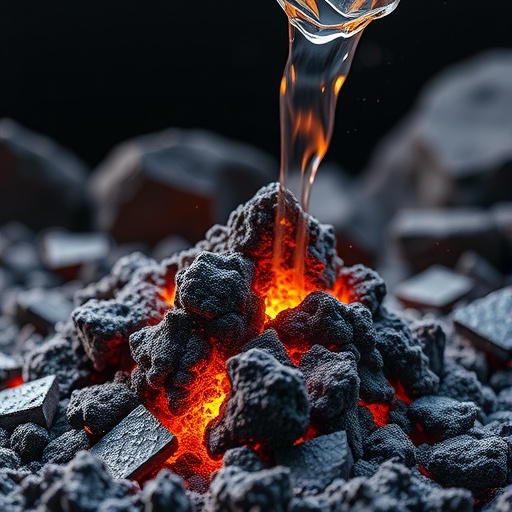In an exploration of innovative materials and sustainability, recent breakthroughs have emerged in the realm of lithium iron phosphate (LiFePO4) crystals, especially in the context of recycling and energy storage applications. As the demand for efficient and sustainable battery technologies increases, researchers are unveiling new methods to repurpose existing materials for enhanced performance. The focus of this research is centered on the melt growth technique for LiFePO4 crystals, derived from carbon-decorated LiFePO4 powder, indicating a significant step in both the recycling of materials and the advancement of battery technology.
The evolution of rechargeable batteries has led to a growing interest in materials that are not only effective but also eco-friendly. Lithium iron phosphate (LiFePO4) has garnered attention due to its impressive thermal stability and safety features compared to other lithium-ion battery materials. The increasing push towards sustainable practices has prompted ongoing research into various methods of synthesizing LiFePO4 with improved characteristics, which can benefit recycling efforts. This innovative approach emphasizes the potential to recycle carbon-decorated LiFePO4 powder, allowing it to be reintegrated into the production of high-quality crystals.
In the detailed study conducted by Fang et al., the melt growth technique employed focuses on the transformation of carbon-coated LiFePO4 powder into crystalline structures that possess superior electrochemical performance. The researchers elucidate the significance of this method, which enables the purification and enhancement of the material’s properties. By utilizing the inherent qualities of carbon-coated powders, the team optimizes the crystallization process, ensuring higher yield and better-quality crystals, which are integral to the efficiency of lithium-ion batteries.
One of the compelling aspects of this research is the reduction of waste associated with battery production. Traditionally, the disposal of used battery materials has raised environmental concerns. However, the innovative extraction of LiFePO4 from recycled sources presents a dual benefit — it not only rejuvenates spent materials but also reduces the need for raw mineral extraction, significantly lowering the carbon footprint associated with battery manufacturing. The implications of this are substantial, especially in the context of global sustainability goals.
The process of melt growth introduced in the study involves heating carbon-decorated LiFePO4 powder to elevated temperatures, facilitating the reconstruction of the material into pure crystal forms. This technique also helps in removing impurities that could otherwise hinder the electrochemical performance of the batteries. By achieving a high degree of crystalline structuring, the researchers enhance the ionic conductivity and overall efficiency of the synthesized LiFePO4 crystals, marking a significant advance in material science.
The researchers conducted numerous experiments to optimize the melting and cooling conditions, crucial for achieving the desired crystal quality. Variation in temperature and time were meticulously controlled, revealing that precise conditions lead to a more homogeneous crystal size and morphology, which directly influences the material’s conductivity and overall performance in applications such as batteries and energy storage systems.
The implications of this research extend beyond just enhanced material properties. The ability to recycle LiFePO4 effectively opens doors for industries focused on green technologies and sustainability. By adopting this methodology, manufacturers can significantly reduce raw material costs and respond more adeptly to the rising global demand for lithium-ion batteries. Furthermore, this research presents a tangible pathway to creating a circular economy within the electronic waste sector by repurposing materials that would typically contribute to pollution.
Moreover, researchers have analyzed the economic viability of this melt growth process. By offsetting the costs related to raw material extraction and processing, the melted growth of recycled LiFePO4 could yield significant savings for battery manufacturers. As the global economy continues to transition toward sustainability, such innovations could lay the groundwork for new industry standards that prioritize the reuse of materials over the consumption of virgin resources.
This research opens the door for future studies to further refine the melt-growth process, potentially diversifying the range of materials that can be effectively recycled. Insights gleaned from this work could inspire the development of similar techniques for other battery materials, fostering a more sustainable battery supply chain capable of meeting the modern world’s energy demands. The transition toward such innovative strategies is crucial, given the urgent need for sustainable and efficient energy storage solutions to combat climate change.
Ultimately, the findings presented by Fang et al. represent not just a scientific milestone but also a compelling argument for the urgent need to innovate within the realm of battery technology. The directed efforts toward reducing waste associated with battery production and supporting the recycling of valuable materials like LiFePO4 can reshape our energy landscape. As the study highlights, we must harness available resources effectively to pave the way for a more sustainable future.
This investigation into LiFePO4 crystal growth encapsulates the fusion of material science and environmental responsibility, making a persuasive case for the potential benefits of recycling strategies in battery technology. The pursuit of sustainable energy solutions hinges on our ability to develop and implement innovative methodologies that reduce waste and enhance performance, signifying a paradigm shift that is essential in today’s context.
In conclusion, the transformative capabilities of recycling LiFePO4 through melt growth suggest a promising horizon for energy efficiency and sustainability in battery technology. As researchers like Fang and colleagues continue to unveil pathways for innovation, the quest for sustainable solutions in energy storage will undoubtedly gather momentum. The implications of this research extend far beyond scientific curiosity; they touch on the very fabric of how we can leverage technology to protect our planet while meeting the growing demands of society.
Subject of Research: Recycling of lithium iron phosphate (LiFePO4) crystals through melt growth from carbon-decorated LiFePO4 powder.
Article Title: Melt growth of LiFePO4 crystals from Carbon-decorated LiFePO4 powder for recycling purpose.
Article References:
Fang, C., Dai, Y., Hao, C. et al. Melt growth of LiFePO4 crystals from Carbon-decorated LiFePO4 powder for recycling purpose.
Ionics (2025). https://doi.org/10.1007/s11581-025-06800-5
Image Credits: AI Generated
DOI: https://doi.org/10.1007/s11581-025-06800-5
Keywords: Recycling, Lithium-ion Batteries, LiFePO4, Melt Growth, Sustainable Materials




